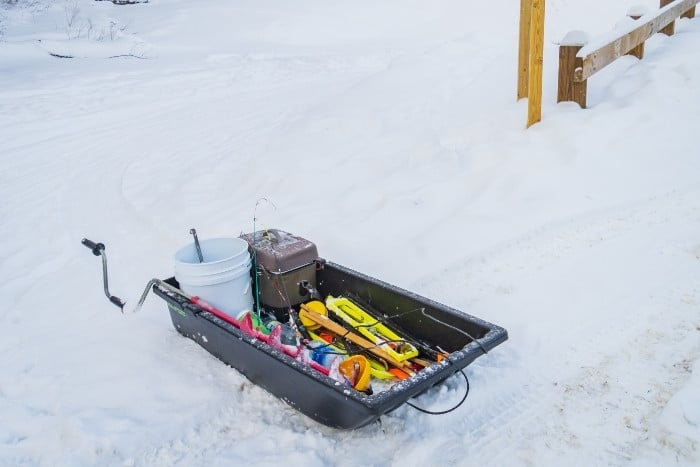Nothing is more annoying if you’re out ice fishing than having your hole freeze back over. Vegetable oil is a standard option to use in the ice fishing hole to prevent it from freezing.
Vegetable oil works well to keep ice fishing holes open due to its low density to stay on top of the water and a low freezing point of 12 degrees Fahrenheit. However, using vegetable oil is messy, bad for the environment, and likely to scare the fish away from your spot.
Keep on reading, and we’ll cover why using vegetable oil in your ice fishing hole is a bad idea and some alternatives to use instead.
Why You Shouldn’t Use Vegetable Oil In Ice Fishing Hole?
While I understand why it is annoying for your ice fishing hole to freeze up, and vegetable oil seems like an attractive option to prevent that, there are a few reasons why it is a bad idea.
To be an educated angler, we’ll cover the harm and bad parts of using vegetable oil when fishing, and after that, we’ll discuss some alternatives.
1. It’s Oily, And Will Get All Over Your Gear
Vegetable oil is, well, oily. This quality makes it great for cooking and gives it interesting properties, but one of the fundamental problems of using vegetable oil is it will get all over everything.
If you pour vegetable oil into the ice fishing hole, you are guaranteed that your gear will quickly get covered. Pulling the fish out will get over your hands, reel, and anything else you touch.
Part of what makes this so annoying is that cleaning vegetable oil off you and your gear is difficult when ice fishing- the oils are hydrophobic, meaning that water alone will not easily rinse off the oil.
While there are more significant impacts that using vegetable oil makes on your fishing experience, the fact that it can be so messy and annoying to use should be enough to scare you away.

2. Vegetable Oil Is Pollution
While vegetable oil is made from vegetables and seems like it would be natural, it’s unfortunately still considered pollution.
Since vegetable oil is highly processed and not found in nature anywhere, it does not belong in the water.
Depending on your local laws, there can even be a hefty fine associated with using vegetable oil or other products to prevent freezing.
Local law enforcement might also be strict about enforcement, meaning you’re likely to get a fine. Whether or not it is against the law, it’s probably best for the environment not to add anything unusual.
Fishing is a great hobby; we need to act responsibly to preserve it for future generations.
3. The Smell Can Scare Fish Away
Fish are typically weary of unusual smells, and vegetable oil is likely strange enough to them that they’ll avoid it.
The more pressured your body of water is, the more likely the fish will stay away from anything unnatural.
Not only is the vegetable oil at the top of the water, but your lure or bait can pick up some oils and bring the smell down with them. This smell can be a real problem and make your lure unattractive to the fish.
The smell of vegetable oil is also not the most pleasant for people, but when ice fishing, plenty of worse smells may be present. Still, it’s nice not to have all your gear smell like vegetable oil.
4. Vegetable Oil Can Be Bad For The Fish
Vegetable oil might not only make it more challenging to catch fish, but it can be bad for fish anyways! There are several reasons for this.
The first reason that vegetable oil is bad for fish is that it can negatively interact with their slime coat.
Fish are naturally covered in a slime that protects them from diseases in the water, but this coat is very delicate. Vegetable oil will damage this slime.
The second reason that vegetable oil is bad for fish is any oils that get into their gills can get stuck and make it more difficult for them to breathe.
And since we mentioned the oil’s hydrophobic properties, it will not come off very well naturally.
Even if you are planning on keeping any fish that you catch, fish that you catch and release will suffer, and you never know if you’re only going to catch keepers.
Alternatives To Using Vegetable Oil
Thankfully, there are plenty of environmentally friendly options to use to prevent your ice hole from freezing over.
All the options below will not leave any pollution in the water and are reusable for future trips.
1. Hole Covers
Hole covers are perhaps the easiest option to use as well as the most durable. They are low-tech, efficient, and inexpensive to purchase or make.
The concept is simple: a piece of plastic or foam is placed in the hole of the ice over the water and insulates it from the outside air keeping it liquid.
You can easily create your own cover with a cut-out piece of insulation foam with a small hole in the center for your line to go through.
Or, if DIY is not your thing, you can purchase a three-pack of Northeast Products insulators for only $6. This option is inexpensive and will last you for many years.
The best part of using a hole cover is setting up a tip-up and leaving it without worrying about the hole freezing over.
2. Hand Warmer In A Ziplock
Another option using materials you likely already have is to put one of those disposable hand warmers into a zip lock bag. With a bit of air in the bag, it will float and keep the water’s surface above freezing.
While not a reusable option, this is an excellent makeshift way to keep the ice fishing hole open for the whole trip.
This option also takes up virtually no space, making it packable and easy to carry if you have to sled your stuff out a distance.

3. Use A Bubbler
A small battery or USB-powered aquarium bubbler is another excellent way to keep the ice from freezing. This option is also inexpensive, lightweight, and reusable.
This option works by pumping air to an airstone underneath the surface of the water and causing a disturbance that makes it harder for the water to freeze.
Moving water freezes less quickly than still water, and the disruption of the water will bring the warmer water up to the surface.
4. Scoop The Ice Out When It Forms
If you are looking for a truly minimal and low-tech option, scooping the ice out when it begins to form is the easiest option.
This option works best if you are actively ice fishing rather than leaving a tip-up. You can bring along a dedicated scoop or use the scoops on the ends of your arms.
While dipping your hands into the ice-cold water might not be ideal, it is truly the most accessible and environmentally friendly option to choose from and requires no extra materials.
Conclusion
All that being said, I hope that you can see why using vegetable oil and other unnatural oils in the water is a bad idea.
The damage to the fish and environment might be seemingly inconsequential at first, but over time can ruin ice fishing for the future.
Besides, vegetable oil guarantees that your gear will be slick and oily, and there are better, cheaper, and more accessible options. A different way to open the ice fishing hole will be a better option.
